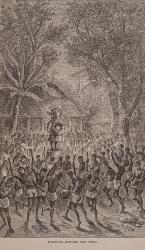Du Chaillu, My Apingi Kingdom: With Life in the Great Sahara. And Sketches of th
My Apingi Kingdom: With Life in the Great Sahara. And Sketches of the Chase of the Ostrich, Hyena, &c. Numerous Engravings.
New York, Harper & Brothers, no year (c.1870). 12.5 cm x 19 cm. Frontispiece with tissueguard, VIII, 254 pages. 33 illustrations. Hardcover [publisher’s original maroon cloth] with gilt lettering and design on spine. Gilt pictoral on front board. Blind stamp to rear board. Coloured pastedowns and endpapers. Very good+ condition with only minor signs of external wear. Interior bright and clean with sharp corners. Tissue guard in very good condition. Preowner details on front endpaper: “James Hill – Westell Farm – Kewell, Read 1916”.
Includes, for example, the following: The Great Falls of Samba-Nagoshi / The Legend of the Porcupine and the Leopard / Killing of the Antelope / An Immense Python / Vapture of A Young Nkago / Leave the Apingi Country / The Ashiras fear the Bakalais / Apporaching th Senegal / The Moors / The Boobees / Fugitive Slaves / Cape of St. John etc.
The book was aimed for younger readers and is full of the typical sensationalist accounts of European derring-do among ‘savages’ amidst tropical hardships.
Paul Belloni Du Chaillu (1831 – 1903) was a French-American traveller, zoologist, and anthropologist. He became famous in the 1860s as the first modern European outsider to confirm the existence of gorillas, and later the Pygmy people of central Africa. (Wikipedia)
Born on the island of Reunion in 1831 to a French trader and a mother of (potentially African) unknown origins, Du Chaillu grew up in France and Gabon before going to the United States in the early 1850s where he taught French and gave lectures and wrote accounts of his experiences in Africa.
With the support from members of the Academy of Natural Sciences of Philadelphia Du Chaillu spent almost four years in what was known as the Gabon on the west coast of central Africa, from 1856-1859. He re-emerged out of the jungle with complete specimens of 20 gorillas. (It was only as recently as the 1840s that the first Western account of the gorilla had been published in the Journal of the Boston Society of Natural History). Darwin’s ‘Origins of the Species’ was published that same year and the gorillas’ resemblance astonished many. After his return to the US, he gave lectures that were so popular that he published a book, Explorations and Adventures in Equatorial Africa, which appeared in the late spring of 1861. By that time, Du Chaillu was in London, exhibiting gorilla skulls and skins to a fascinated public, along with a variety of other animal specimens that he had brought back. However, his book – part sensationalist travel narrative written with lurid prose making much of cannibalism and stories of fetishism, while, at the same time, a work of scientific analysis and rigour – was criticized by numerous naturalists, who challenged Du Chaillu’s credentials as a scientist and were sceptical of the truth of his accounts of encounters with gorillas. It was also highlighted that several of his illustrations were copied without credit from other sources and presented as if they portrayed Du Chaillu’s own specimens. However, Du Chaillu was supported by the eminent scientists in the UK Thomas Henry Huxley and Sir Richard Owen of the British Natural History Museum. Though he reputation was sullied among the scientific community he was still a popular lecture presenter and went onto author numerous books on his travels in Africa and elsewhere for a public ever ready for adventure and the exotic. (Stuart McCook, “It May Be Truth, but It Is Not Evidence”: Paul du Chaillu and the Legitimation of Evidence in the Field Sciences,” Osiris Vol. 11, Science in the Field (1996), pp. 177-197, available from J-Stor website)
Recent interpretations of the controversy highlight the role race, and Victorian attitudes to race, played in the often personal attacks on the mixed-race DuChaillu (Richard Conniff, ‘Race, Sex and the Trials of a Young Explorer,’ New York Times, February 13 2011, available online)
Elaine Ayers, writing in ‘The Appendix,’ asserts that Edward Rice Burroughs’ Tarzan and the Apes drew heavily on DuChaillu’s sensationalists accounts of his West African expeditions. (Elaine Ayers, ‘Hunting Gorillas in the Land of Cannibals: Making Victorian Field Knowledge in Western Equatorial Africa,’ The Appendix, Vol.2, No.2, April 2014, available online)
- Keywords: 19th Century · Africa · Africa – Rare · Africana Collection of Rare Books · Animals · Big Game · Colonialism · Desert · Elephants · Hunt · Hunting – Rare · Moors · Native, Rituals and Customs · Natives · Nature · Safari · Sahara · Senegal · Slave trade · Slavery · Travel · Travel Africa – Rare · Travel and Adventure · Travel Writing · Travellers · Travelling Authors
- Language: English
- Inventory Number: 120112AB
EUR 375,--
© 2024 Inanna Rare Books Ltd. | Powered by HESCOM-Software














